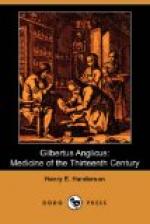If, however, the wound is large, a pledget (pecia) of lint, long enough to extend from one end to the other and project a little, is placed in the wound, and over this the exterior portion of the wound is to be carefully sewed, and sprinkled daily with the pulvis ruber. Every day the pledget which remains in the wound is to be drawn towards the most dependent part, so that the dressing in the wound may be daily renewed. When the intestinal wound is found to be healed, the entire pledget is to be removed and the unhealed openings dressed as in other simple wounds. The diet of the patient should be also of the most digestible sort.
Thus far Gilbert has followed Roger almost literally. But he now adds, apparently upon his own responsibility, the following paragraph:
Quod si placuerit, extrahe canellum: factis punctis in sutura ubi debent fieri antequan stringantur, inter duo puncta canellus extrahatur, et post puncta stringantur. Hoc dico si vulnus intestini sic (sit) ex transverso.
Apparently Gilbert feels some compunctions of conscience relative to the ultimate disposition of the canula of alder-wood, and permits, if he does not advise, its removal from the intestine before the tightening of the last stitches.
Roland adds nothing to the text of Roger. But The Four Masters (Quatuor Magistri, about A.D. 1270) suggest that the canula be made of the trachea of some animal, and add:
Canellus autem per processum temporis putrefit et emittur per egestionem, et iterum per concavitatem canelli transibit egestio.
In his further discussion of wounds of the intestine and their treatment Gilbert also volunteers the information that:
“Mummy (shade of Lord Lister!) is very valuable in the healing of wounds of the intestine, if applied with some astringent powder upon the suture.”
In amends for the mummy, however, we are also introduced to the practice of mediaeval anaesthesia by means of what Gilbert calls the Confectio soporifera (f. 234d), composed as follows:
R.
Opii,
Succi Jusquiami (hyoscyami),
Succi papaveris nigri, vel ejus seminis,
Sacci mandragorae, vel ejus corticis,
vel pomorunt ipsius si succo
carueris,
Foliorum hederae arborae (ivy),
Succi mororum rubi maturorum,
Seminis lactucae,
Succi cuseutae (dodder), aa. ounce
I.
Mix together in a brazen vessel and place this in the sun during the dog-days. Put in a sponge to absorb the mixture, and then place the sponge in the sun until all the moisture has evaporated. When an operation is necessary, let the patient hold the sponge over his nose and mouth until he goes to sleep, when the operation may be begun. To awaken the patient after the operation, fill another sponge with vinegar and rub the teeth and nostrils with the sponge, and put some vinegar in the nostrils. An anaesthetic drink may also be prepared as follows:




